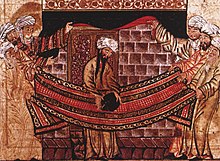| Revision as of 14:00, 28 February 2007 editALM scientist (talk | contribs)Extended confirmed users, Pending changes reviewers7,390 edits rv: I have already given you 3 citation telling the calligraphy is the tradition instead of picture and shown 49 books too. That is enough.← Previous edit | Latest revision as of 07:05, 1 August 2023 edit undoLilianaUwU (talk | contribs)Extended confirmed users, Page movers, Pending changes reviewers, Rollbackers41,692 editsm rvvTags: Rollback Disambiguation links added | ||
| (230 intermediate revisions by 61 users not shown) | |||
| Line 1: | Line 1: | ||
| {{aan}} | |||
| <includeonly>{{#switch: {{{1}}} | |||
| |1=</includeonly><!-- | |||
| --><noinclude> | |||
| ==Image(s) 1== | ==Image(s) 1== | ||
| ] started in the 17th century by Hafiz Osman.<ref name="Ali7">Ali, Wijdan. "". In ''Proceedings of the 11th International Congress of Turkish Art'', eds. M. Kiel, N. Landman, and H. Theunissen. No. 7, 1–24. Utrecht, The Netherlands, August 23-28, 1999, p. 7</ref>{{Ed right2|Muhammad/images|section=1}}]] | |||
| </noinclude><!-- | |||
| Edit image details between this line --> | |||
| ].{{Ed right2|Muhammad/images|section= |
]. Muhammad's face is veiled, a practice followed in the ] since the 16th century.<ref name="Ali7">Ali (1999), p. 7</ref>{{Ed right2|Muhammad/images|section=3}}]] | ||
| ] (16th century) Beautiful fresco painting with floral designs surrounding the words "Allah" and "Muhammad" in blue. Inscribed inside the names are calligraphic verses from the Quran in white paint of which the one inside the word "Allah" is the Ayat-ul-Kursi and the one inscribed inside the word "Muhammad" affirms the finality of Prophethood with the Prophet Muhammad.]] | |||
| <!-- and this line --> | |||
| <includeonly>}}</includeonly><!-- | |||
| --><noinclude> | |||
| <br style="clear:both" /> | <br style="clear:both" /> | ||
| </noinclude><!-- | |||
| --><includeonly>{{#switch: {{{1}}} | |||
| |2=</includeonly><!-- | |||
| --><noinclude> | |||
| ==Image(s) 2== | ==Image(s) 2== | ||
| ⚫ | ] painting celebrating Muhammad's ascent into the Heavens, a journey known as the ]. Muhammad's face is veiled, a practice in ] of this ]. {{Ed right2|Muhammad/images|section=2}}]] | ||
| </noinclude><!-- | |||
| Edit image details between this line --> | |||
| ⚫ | ] painting celebrating Muhammad's ascent into the Heavens, a journey known as the ]. Muhammad's face is veiled, a |
||
| <!-- and this line --> | |||
| <includeonly>}}</includeonly><!-- | |||
| --><noinclude> | |||
| <br style="clear:both" /> | <br style="clear:both" /> | ||
| </noinclude><!-- | |||
| --><includeonly>{{#switch: {{{1}}} | |||
| |3=</includeonly><!-- | |||
| --><noinclude> | |||
| ==Image(s) 3== | ==Image(s) 3== | ||
| ] and showing Muhammad re-dedicating the Black Stone at the Kaaba. From ], ] and can be found in ]s ] ("''The Universal History''" or "''Compendium of Chronicles''"), held in the ].<ref>Ali, Wijdan. "". In ''Proceedings of the 11th International Congress of Turkish Art'', eds. M. Kiel, N. Landman, and H. Theunissen. No. 7, 1–24. Utrecht, The Netherlands, August 23-28, 1999, p. 3</ref>{{Ed right2|Muhammad/images|section=3}}]] | |||
| </noinclude><!-- | |||
| Edit image details between this line --> | |||
| ] of Pre-Prophethood Muhammad re-dedicating the Black Stone at the Kaaba. From ], ] and can be found in ]s ] ("''The Universal History''" or "''Compendium of Chronicles''"), held in the ].{{Ed right2|Muhammad/images|section=3}}]] | |||
| <!-- and this line --> | |||
| <includeonly>}}</includeonly><!-- | |||
| --><noinclude> | |||
| <br style="clear:both" /> | <br style="clear:both" /> | ||
| </noinclude> | |||
| ==Image(s) 4== | |||
| <!-- Unsourced image removed: ] in ].{{Ed right2|Muhammad/images|section=4}}]] --> | |||
| <br style="clear:both" /> | |||
| ==Image(s) 5== | |||
| ] by ], depicting Muhammad preaching the Qur'an in Mecca.<ref name=maome>{{cite web | publisher=] | url=http://expositions.bnf.fr/livrarab/grands/0_01.htm | title=Le Prophète Mahomet | publication=L'art du livre arabe | accessdate=03-02-2007}}</ref>{{Ed right2|Muhammad/images|section=5}}]] | |||
| <br style="clear:both" /> | |||
| ==References== | |||
| {{Reflist}} | |||
Latest revision as of 07:05, 1 August 2023
| This is an archive of past discussions about Muhammad. Do not edit the contents of this page. If you wish to start a new discussion or revive an old one, please do so on the current talk page. |
| Archive 1 | Archive 2 | Archive 3 | Archive 4 | Archive 5 |
Image(s) 1

Image(s) 2
Image(s) 3

Image(s) 4
Image(s) 5

References
- ^ Ali, Wijdan. "From the Literal to the Spiritual: The Development of Prophet Muhammad's Portrayal from 13th Century Ilkhanid Miniatures to 17th Century Ottoman Art". In Proceedings of the 11th International Congress of Turkish Art, eds. M. Kiel, N. Landman, and H. Theunissen. No. 7, 1–24. Utrecht, The Netherlands, August 23-28, 1999, p. 7 Cite error: The named reference "Ali7" was defined multiple times with different content (see the help page).
- Ali, Wijdan. "From the Literal to the Spiritual: The Development of Prophet Muhammad's Portrayal from 13th Century Ilkhanid Miniatures to 17th Century Ottoman Art". In Proceedings of the 11th International Congress of Turkish Art, eds. M. Kiel, N. Landman, and H. Theunissen. No. 7, 1–24. Utrecht, The Netherlands, August 23-28, 1999, p. 3
- "Le Prophète Mahomet". Bibliothèque nationale de France. Retrieved 03-02-2007.
{{cite web}}: Check date values in:|accessdate=(help); Unknown parameter|publication=ignored (help)